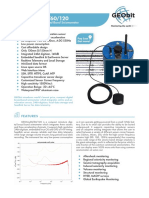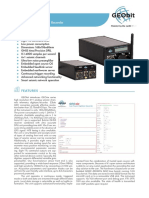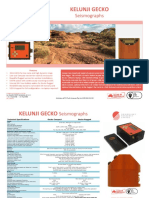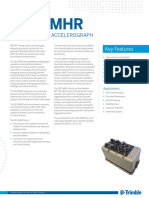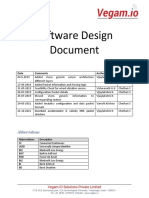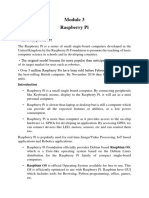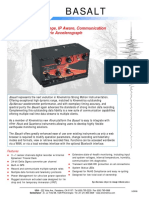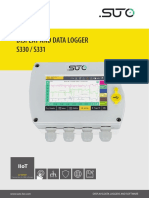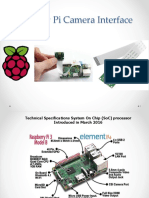Specifications for: Raspberry Shake 3D
- Your 3D Personal Seismograph -
An IoT home-automation device
Born on: February, 2017
https://shop.raspberryshake.org/
sales@raspberryshake.org
Last updated: 21-sept-2020
Unit
The Raspberry Shake 3D Personal Seismograph is an all-in-one, IoT plug-and-go solution for
personal seismology that integrates a 3 orthogonal velocity sensors, the digitizers, the hyper
dampers, and the computer into a single box. The Raspberry Shake 3D Personal Seismograph
is manufactured in Panamá using cutting-edge 3D printing and laser-cutting technology.
Warranty: 1 year from ship date
Specifications subject to change without notice.
Parameter Value
Raspberry Shake 3D Version All versions
Dimensions (estimated) Standard enclosure: 140x135x60 mm
IP67 enclosure: 160x90x90 mm
Weight (estimated) 0.6 kg
Immersion rating Standard enclosure: IP10
IP67 enclosure available upon request at
additional cost
Connectors Standard enclosure: Ethernet (RJ45), Power
Micro USB (5V, 2.5 Amps), USB 2 ports x4,
HDMi, Micro SD, CSI Camera port,
Composite video and audio output jack
IP67 enclosure: Ethernet (RJ45), Power
Installation Considerations Designed for plug-and-go installation
Operating Temperature 0 to 60 C (limited by RPi, the Raspberry
Shake itself can go to -20C)
On Board Computer Raspberry Pi 3 Model B
The Raspberry Shake board/ Software is also
compatible with:
00[10,13],900032: Model B+
a[01040,01041,21041,22042]: 2 Model B
a[02082,22082,32082,52082]: 3 Model B
a020d3: 3 Model B+
4 Model B
Storage Device 8 Gb or + micro SD card
Est. # days of disk space:
OS/ software: ~3 Gb
Remaining space for data: ~5 Gb
# days (15 Mb/ day/ channel [x3]): ~110, more
if you use a bigger SD
Timing Network Timing Protocol, NTP (default)
GPS timing supported
Timing Quality NTP timing quality remains within 1 sample of
accuracy versus startup accuracy: +/- 10 ms
or better @ 100 sps
Seismograph
Parameter Value
Type 3-component, orthogonally placed 4.5 Hz (electronically
extended down to 2 seconds) Sunfull PS-4.5B geophones,
375 Ohm
Note: These are not the same geophones used in the 1D and 4D
versions of Raspberry Shake
Samples per second 100
Earthquake Early Warning (EEW) compatible
data packets shipped across serial port at a rate of 4 packets/ second (250 ms/ packet)
Bandwidth (estimate) V5+: -3dB points at 0.7 to 39 Hz
V3: -3dB points at 0.6 to 34 Hz
Poles (estimate, V5+:
radians/ second)
-1 (0.16 Hz, single pole high pass filter)
-3.03 x2 (0.48 Hz, double pole high pass filter)
-666.67 (106 Hz, single pole low pass filter)
V3: 2.23E+02 +/- 2.95E+02; 3.76E-01; 0
Zeros (estimate, V5+: 0, 0, 0
radians/ second)
V3: -1.96E+02 +/- 1.55E+02; 2.65 +/- 6.83E-01
Sensitivity (estimate) V5+: 3.60E+08 counts/ meter/ second +/- 10% precision
V3: 3.53E+08 counts/ meter/ second +/- 10% precision
Clip Level (estimate) +/- 8,388,608 counts (24-bits)
V5+/ V3: 24 mm/s peak-to-peak from 0.1 to 10 Hz
Minimum Detection V5+: 0.03 µm/ s RMS from 1 to 20 Hz @ 100 sps
Threshold (estimate)
V3: 0.06 µm/ s RMS from 1 to 20 Hz @ 100 sps
Note: The minimum detectable level is considered to be 10
dB above the noise RMS. Dynamic range is the full scale
sinusoid RMS over the noise RMS in dB.
Digitizer 24-bit ADC Sigma-Delta 𝚺𝚫
Dynamic range 144 dB (24 bits)
Effective bits (estimate) V5+: 21 bits (124 dB) from 1 to 20 Hz @ 100 sps (for the
entire analog to digital hardware chain).
V3: 20 bits (120 dB) from 1 to 20 Hz @ 100 sps (for the
entire analog to digital hardware chain).
Note: Whereas most manufacturers report this for their
digitizer only, we are reporting it for the entire sensor + ADC
hardware chain. The effective bits of the digitizer itself are
necessarily better.
This parameter is also commonly known as “Dynamic
Range”; “RMS to RMS noise"; or "noise free bits".
Velocity Channel Instrument Response:
Sleeman Self-noise:
Software
Software installed on Raspberry Shake's RPi computer
100% SeisComP3 compatible
Also: AQMS, Antelope, Earlybird, Earthworm, Hydra, ObsPy, SEISAN, …
Native SeedLink Server (source: GEOFON) with Raspberry Shake’s Data Flow Message
Router
Tight and automatic integration with SeisComP
Web-interface (HTML) for easy configuration
Software to store continuous seismic data in miniSEED format
Web-based helicorder plot generator (source: USGS)
Swarm (source: USGS)
Software distributed with Docker
Automatic updates
Operating System: Debian 8 (Linux)
Communications
Parameter Value
Digital bandwidth consumption at 100
Average:
Hz, per channel
820 bytes/ second
71 megabytes/ day
Max:
1420 bytes/ second
123 megabytes/ day
TCP/IP compatible
Compatible with Ethernet, Cell, GPRS, Satellite modems
Power
Parameter Value
Power Supply Voltage 5 Volts DC (2.5 Amp supply)
Power Consumption (RPi + Startup: 5 Volts x 0.550 A = 2.8 Watts
Raspberry Shake, estimated)
Run-time: 5 Volts x 0.320 A = 1.6 Watts
Calibration Mechanism: Calibration not required over time but can be verified using the OSOP
Calibration Table. All seismographs are verified prior to shipping to ensure that their gain is
within 10% of the nominal instrument response (up to 10% variation attributable to geophones
and capacitors).
Questions?
Email us at sales@raspberryshake.org






